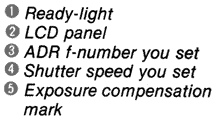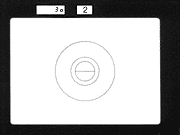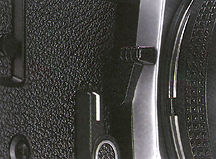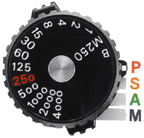 Power switch is turned on by first stroke of shutter release button when power voltage is approx. 2.45V or more, power stays on for 16 sec. after finger is lifted off button, also it stays on for 16 sec. after mirror down. When power voltage is approx. 2.44V or less, power stays on only for approx. 0.2 sec. to warn low battery power. When power voltage is approx. 2.3V or less, LCD readout and LED displays (ready-light, exposure compensation) are turned out, and electromagnetic shutter release is locked. ' Ready-light LED can light up, when shutter speed dial is set at B or M250.  |
The+ viewfinder information is a combination of LCD (Liquid Crystal Display), LEDs (Light Emitting Diode) and by mechanical/optical mean (ADR - Aperture Direct Readout). The screen supplied is the standard Nikon type K focusing screen with Matte Fresnel field with central split image rangefinder surrounded by microprism ring. The external 12mm diameter outlines the center weighted metering area.
|
Exposure modes
To summarize the various exposure
control modes (Metering option are, AMP (Matrix), center-weighted and stopped down
AE) available in the FA, there are a total of 4 modes : Manual, Aperture Priority,
Shutter Priority and a Program mode. The program mode can segment into high speed
and normal program automatically if an AI-S lens is used. Further, a TTL OTF auto
flash metering mode when used y with Nikon dedicated flash units.
Changes in the expsoure
modes affect the way how the viewfinder information display. We will go through these
one by one and then we will discuss the metering modes after that.
Manual Mode:
 |
The digital LCD display shows the shutter speed you set, prefixed by "M" "-+ 125" means Correct exposure, " -M : 125" under-exposure and "+M : 125" overexposure The aperture f-number you set is shown at top center, the info is by means of the ADR window to relay the aperture F value set on your aperture ring of your lens to the optical viewfinder - such data is only available if you are using a minimum AI modified lens with engraved f-values on the aperture ring. |
Most of the time, the manual mode
in the Nikon FA has been ignored by many (Those who doesn't like automatic camera).
On 'M', it's entirely up to you to determine which aperture and shutter speed to
utilize to render a specific scene whether in color or black-and-white. All 13 shutter
speeds from 1/4000 to 1 sec. are digitally controlled and based on a much superior
524.288kHz quartz oscillation (Compared with FE2's 32,768 kHz quartz clock speed)
for absolutely precise timing. Inside the viewfinder, the digital LCD shutter speed
indication at top left and to the aperture f-number you set at top center. In the
Manual exposure mode, the AMP metering feature is not available, instead the FA's exposure metering
system automatically changes to center-weighted metering system.
Aperture Priority AE
  |
The f-number you set on your lens is shown through the ADR (aperture direct readout) window. The LCD readout shows the shutter speed selected by the camera. " |
Aperture-Priority with
Stopped-Down Auto Exposure
Aperture priority AE is the 'mode of choice' for many other Nikon automatic cameras.
The Nikon FG is the first which offers program AE while the FA is the first Nikon
that has Shutter Priority AE, as built in automatic function (I used 'built in"
because as early as the Nikon F2S with EE Aperture Control Device
DS-1 (Or DS-2 with
F2SB) - can convert the mechanical F2 bodies into an Shutter Priority cameras!).
As Michael Liu's F2 site is still under development, I will port the info for DS-1,
2, DS-11 & DS-12 for the F2A and F2AS respectively into that site later).
In this mode, as you set the lens aperture, the camera will automatically picks the matching stepless shutter speed for correct exposure. 'Stepless' means it will be precisely, based on the metering, go to the fraction in shutter speed. For example, 1/286 sec or 1/3613 sec to match your lens' aperture value, based on a given specific metered scene of brightness. Aperture-Priority auto-exposure control enables you to control depth of field, thus giving you full access to the selective focusing technique. Depth of field becomes shallower as you gradually open up the lens. Aperture-Priority auto-exposure mode is also very much convenient compared with Shutter Priority AE when using lenses with fixed apertures such as mirror or Reflex lenses.
 |
Further, although bellows equipment doesn't have an automatic aperture lever, you can use it with the FA in the Aperture-Priority stopped-down auto-exposure mode by depressing the FA's depth-of-field preview lever completely as the shutter release button is pressed; centerweighted metering is automatically activated even if you have set the metering selector mode to AMP. |
The digital LCD readout shows the metered shuttered speed. But again, a word of reminder - IF your lens is an AI (Automatic Indexing) Nikkor, please DON'T NOT use the stopped down method to meter, as it will generate unaccurate exposure reading.
* Note: The Basic Operation Section in this site has two parts covering these info, you may check with that for more details.
| Back | Next | The Shutter Priority AE and Dual Program AE
| Back | to Main Index Page of Nikon FA
Other Technical Issues: Part I | Part II
The AI-S Nikkors (related info | TTL OTF Flash Metering | Interchangeable Focusing Screens. The MD-15/MD12/MD11 Motor Drives | 3rd party Power Winder (new) | Flash Units -SB-16 | SB-15 | SB-10 | SB-16B & Other Options | Databacks | Titanium Shutter | Variation : Mr Y K Wong from Singapore contributing 11 images of his Nikon FA GOLD
| Nikon FM series |
Nikon FE series |
Nikon
FA |
W A R N I N G: The New G-SERIES Nikkor lenses have no aperture ring on the lens, they CANNOT ADJUST APERTURES with any of these manual focus Nikon FE series SLR camera models; please ignore some portion of the content contained herein this site where it relates.
| Message Board | for your favourite Nikon FA camera
| Message Board | for your Nikon Optics in a shared environment
| Message Board | Specifically for Dispose or Looking for Nikon / Nikkor Photographic Equipment
Shared Resources: MD-11 | MD-12 | 3rd Party Power Winder Only for FM2(n)/FE2/FA | Focusing Screens | Titanium Shutter | Flash Units - | SB-15 | SB-10 | SB-16B & Other Options | Databack | Nikkor lens mount (related info)
Others:- Nikon AF-TTL Speedlights | SB-20 (1986) | SB-22 (1987) | SB-23 | SB-24 (1988) | SB-25 (1991/2) | SB-26 (1994) | SB-27(1997) | SB-28 (1997) | Nikon SB-29(s) (2000) | Nikon SB-30 (2003) | Nikon SB-600 (2004) | Nikon SB-800 (2003) Nikon AF-TTL Speedlight DX-Series: Nikon SB-28DX (1999) | SB-50DX (2001) | SB-80DX (2002)
Nikon
BC-flash Series |
Original
Nikon Speedlight
SB-2 | SB-3
| SB-4
| SB-5
| SB-6 | SB-7E
| SB-8E
| SB-9 | SB-E
| SB-10
SB-11
| SB-12 | SB-14 | SB-140 UV-IR| SB-15 | SB16A | SB-17 | SB-18, SB-19 | SB-21A (SB-29) Macro flash | Flash Accesories | SF-1
Pilot Lamp
| Nikon F | Nikon F2 | Nikon F3 | Nikon F4 | Nikon F5 | Nikon F6 | Nikkormat / Nikomat | Nikon FM | Nikon FE/ FA | Nikon EM/FG/FG20 | Nikon Digital SLRs | Nikon - Other models |
Nikon Auto Focus Nikkor lenses:- Main
Index Page
Nikon Manual Focus Nikkor lenses:- Fisheye-Nikkor Lenses - Circular | Full Frame |
Ultrawides Lenses - 13mm15mm18mm20mm | Wideangle Lenses - 24mm28mm35mm | Standard Lenses - 45mm 50mm 58mm | Telephoto
Lenses - 85mm105mm135mm180mm & 200mm | Super-Telephoto Lenses - 300mm 400mm 500mm 600mm 800mm 1200mm |
 Index Page |
Special
Application lenses: Micro-Nikkor Lenses - 50mm~55mm -60mm 85mm -105mm 200mm Micro-Zoom 70-180mm Perspective Control (PC) - 28mm 35mm PC-Micro 85mm Dedicated Lenses for Nikon F3AF: AF 80mm f/2.8 | AF 200mm f/3.5 EDIF Depth of Field Control (DC): 105mm 135mm Medical Nikkor: 120mm 200mm Reflex-Nikkor Lenses - 500mm 1000mm 2000mm Others: Noct Nikkor | OP-Nikkor | UV Nikkor 55mm 105mm | Focusing Units | Bellows-Nikkor 105mm 135mm Nikon Series E Lenses: 28mm35mm50mm100mm135mm | E-Series Zoom lenses: 36~72mm75~150mm70~210mm |
MF Zoom-Nikkor Lenses: 25~50mm | 28~45mm | 28~50mm | 28~85mm | 35~70mm | 36~72mm E | 35~85mm | 35~105mm | 35~135mm | 35~200mm | 43~86mm | 50~135mm | 50~300mm | 70~210mm E | 75~150mm E | 80~200mm | 85~250mm | 100~300mm | 180~600mm | 200~400mm | 200~600mm | 360~1200mm | 1200~1700mm
Tele-Converters: TC-1 | TC-2 | TC-200 | TC-201 | TC-300 | TC-301 | TC-14 | TC-14A | TC-14B | TC-14C | TC-14E | TC-16 | TC-16A | TC-20E
Recommended links to understand more technical details
related to the Nikkor F-mount and production Serial Number:
http://rick_oleson.tripod.com/index-153.html by: my
friend, Rick Oleson
http://www.zi.ku.dk/personal/lhhansen/photo/fmount.htm by: Hansen,
Lars Holst
http://www.mir.com.my/rb/photography/hardwares/nikonfmount/lens2.htm
http://www.photosynthesis.co.nz/nikon/serialno.html
|
Back | Main Index Page of Nikkor Resources
|
Back | Main Index Page of Pictorial
History of Nikon SLRs
| Message Board | for your Nikkor optics ("shared" because I do wish some of you to expose to other's perspective as well. Isn't it a sad sate to see photography has to be segmented into different camps from the use of various labels)
about this photographic web site
Home - Photography in Malaysia |
A contributing effort to Michael C Liu's Classic Nikon Site.
Credit: Chuck Hester for some of his beautiful images used in this site; Ted Wengelaar®, Holland for his continuous flow of input; Lars Holst Hansen, Danish 'Hawkeye' who shares the same passion; Mr Poon from Poon photo for their input; Ms Miss Rissa (Sales Manager) & members of the Technical Service dept. of Shriro Malaysia, local distributor of Nikon cameras in Malaysia & Singapore, in providing so many useful input to make this site possible. Special thanks to Mr MC Lau, who has helped with his images of the MF-12 databack. Michael Tan, Pertama Photo (603-2926505) for lending his original Titanium Shutter Display Unit. Dave Hoyt who has prepared the introductory page and offer some images of his FE2 in this site.. Hiura Shinsaku, Nikomat ML, Japan for his contribution on all the various images; A contributing site to a long lost friend on the Net. Note: Certain content and images appeared in this site were either scanned from official marketing leaflets, brochures published by Nikon and/or contribution from surfers who claimed originality of their own work to publish in this site based on educational merits. The creator of this site will not be responsible for any discrepancies that may arise from such possible dispute except rectifying them after verification."Nikon", "Nikkormat", "Nippon Kokagu KK" & "Nikkor" are registered tradename of Nikon Corporation Inc., Japan. Made witha PowerMac.


